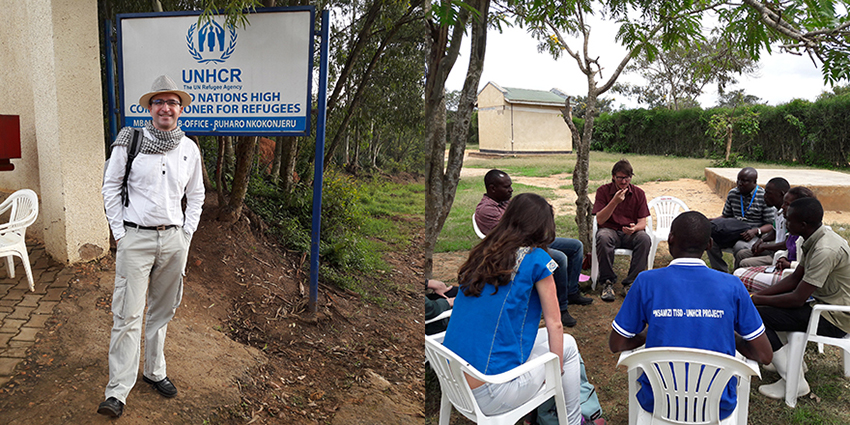By Alexia Van Rij & Philippe Guichandut, Grameen Crédit Agricole Foundation

What if microfinance was the key to integrating refugees?
Often perceived as risky and instable customers, refugees are generally not or poorly assisted by financial service providers, despite blatant needs. Yet, the few instances of loans granted to refugees seem to present successful outcomes[1].
In light of this observation, the UNHCR (United Nations High Commission for Refugees) and the Sida (Swedish International Development Cooperation Agency) launched a programme promoting access to financial and non-financial services for refugees in Uganda and in Jordan. Thus, the Grameen Crédit Agricole Foundation was selected to support its partner microfinance institutions to reconsider the issue of refugees in their strategy.
Microfinanza[2] was in charge of the first study on the needs to access financial and non-financial services. In this context, we spent three days in the Nakivale camp, in the South of Uganda, experiencing fascinating exchanges and encounters with Burundian, Rwandan, and Congolese refugees.
At the heart of Nakivale in Uganda: a strong need to access financial services
Uganda is the third most important host country in the world in number of refugees, with more than 1.4 million refugees by the end of March 2018. Following the crisis in South Soudan in 2013, an increasing number of refugees entered Uganda: the UNHCR estimates around 1,800 per day. The country has one of the most favourable refugee policies in the world, allowing them to receive a piece of land to cultivate, to work, to gain free access to Ugandan social services (education, health), to enjoy freedom of movement and to receive identity papers. In this remarkable context, the Foundation joined the Microfinanza team in Nakivale, one of the oldest refugee camps in Uganda, to assist them in their study with the refugees.
Nakivale now hosts more than 100,000 people, mostly from Rwanda, Burundi and Democratic Republic of Congo, divided in small localities over 185 km2. Most of residents in Nakivale have benefited from pieces of land granted by the government, used for agriculture and farming. Others manage a small restaurant, a hair salon or a clothing store. In sum: classic activities for microfinance institutions. However, no microfinance institution is involved in the camp and refugees must rely solely on solidarity within the camp.
Moban Sacco, a credit savings organisation with no less than 1,449 members, arose from mutual aid in the face of a lack of capital. Thanks to Moban Sacco, refugees can save up small amounts and can receive some credits, but this is unanimously considered as not enough to enable them to really develop their businesses.
Dismissed prejudices
One of fears that microfinance institutions have towards refugees is that the latter will return to their country of origin without paying their debts. It must be noted that in Nakivale, none of the refugees interviewed project to go back to their country of origin because of the level of insecurity in those regions, some of them being settled in the camp for more than 15 years (7-8 years on average) with the firm intention of developing their micro-enterprise on the spot.
Moreover, all the refugees we met maintained that they had a concrete idea of how they would use a loan if it were granted to them. In other words, ideas are not lacking but the capital is! How could we forget this woman’s story, from the region of Kivu, Congo, who was the sole provider of her three children, hairdresser and whose 11-year old son was translating her words because she strove her whole life for him to learn English? After she left her country without any money, she did not have the means to start up her hair salon and she was dependent on food rations provided by the UNHCR to survive with her three children. Or, what about our encounter with a Rwandan head of company, who created, six years ago, with his few economies, a company to grind seeds. He succeeded in employing three people to develop his activity, but his small savings did not allow him to expand his business and buy new high-performance equipment.
These examples, amongst many others, highlight how diverse circumstances can be, and how women and men with great talents, experiences and will to take control of their own destiny, often see their potential wasted, although they could have done it in their country of origin before the situation got out of their control.
At the Foundation, we are convinced that microfinance institutions, while adapting their products and services, have an active role to play in promoting the financial inclusion of refugees. Opportunities for digital finance, an in-depth knowledge of each group’s characteristics and a regular follow-up should stimulate such an involvement. Meetings with partner microfinance institutions of the Foundation lead to believe that they will be involved and will take on the challenge of offering inclusive financial services to refugees and their host communities.
The ongoing study alongside with Microfinanza that will be made public this year should provide concrete guidelines for our partners to get actively involved. With our support and the joint work with UNHCR and Sida, that can be a reality.
_______________________________________________________